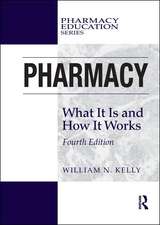Computational Design of Chemicals for the Control of Mosquitoes and Their Diseases: QSAR in Environmental and Health Sciences
Editat de James Devillersen Limba Engleză Hardback – 4 ian 2018
Preț: 1670.29 lei
Preț vechi: 2036.94 lei
-18% Nou
Puncte Express: 2505
Preț estimativ în valută:
319.62€ • 341.77$ • 266.48£
319.62€ • 341.77$ • 266.48£
Carte tipărită la comandă
Livrare economică 17 aprilie-01 mai
Preluare comenzi: 021 569.72.76
Specificații
ISBN-13: 9781498741804
ISBN-10: 1498741800
Pagini: 482
Ilustrații: 660
Dimensiuni: 156 x 234 x 35 mm
Greutate: 0.93 kg
Ediția:1
Editura: CRC Press
Colecția CRC Press
Seria QSAR in Environmental and Health Sciences
Locul publicării:Boca Raton, United States
ISBN-10: 1498741800
Pagini: 482
Ilustrații: 660
Dimensiuni: 156 x 234 x 35 mm
Greutate: 0.93 kg
Ediția:1
Editura: CRC Press
Colecția CRC Press
Seria QSAR in Environmental and Health Sciences
Locul publicării:Boca Raton, United States
Cuprins
Contents. Series Introduction. Acknowledgments. Contributors. Chapter 1 Repurposing Insecticides and Drugs for the Control of Mosquitoes and their Diseases. Chapter 2 Insect Olfactory System as the Target for Computer-Aided Design of Mosquito Repellents. Chapter 3 OBP-Structure-Aided Repellent Discovery: An Emerging Tool towards the Prevention of Mosquito-Borne Diseases. Chapter 4 Molecular Topology as a Powerful Tool for Searching new Repellents and Novel Drugs against Diseases Transmitted by Mosquitoes. Chapter 5 Pharmacophore modeling applied to mosquito borne diseases. Chapter 6 Comparative MIA-QSAR Proteochemometric Analysis of NS3 Protease Substrates in Dengue Virus. Chapter 7 Mosquito-Active Cry d -Endotoxins from Bacillus thuringiensis subsp. israelensis: Structural Insights into the Toxin-Induced Pore Architecture. Chapter 8 Structural Scaffolding for New Mosquito Larvicides. 9 SAR and QSAR Modeling of Structurally Diverse Juvenoids Active on Mosquito Larvae. Chapter 10 SAR predictions of benzoylphenylurea chitin synthesis inhibitors active on larvae of Aedes aegypti. Chapter 11 Predicting the toxicity of piperidines against female adults of Aedes aegypti. Chapter 12 Molecular modeling studies of the inhibition by natural compounds of a mosquito detoxification system, implication in mosquito vector control. Chapter 13 Critical review of models for exposure assessment of residents and bystanders to adulticides used in mosquito control. Chapter 14 Occupational exposure scenarios and modeling in vector control. Chapter 15 Use of insecticides indoor for the control of mosquitoes: Exposure scenarios and modeling. Index
Notă biografică
PhD in ecotoxicology (1987, University Lyon I, France). Head of CTIS. Publications: 245 peer-reviewed papers and book chapters. 15 authored/edited books. Founding editor (1993) and editor-in-chief (1993 to present) of the journal SAR and QSAR in Environmental Research (Gordon & Breach Science Publishers and now Taylor & Francis). Co-Editor of the journal Toxicology Methods (Taylor & Francis, 1997 to 2002). Member of the editorial board of: Journal of Biological Systems (World Scientific, 1995 to 1997). Toxicology Mechanisms and Methods (Taylor & Francis, 2002 to 2009). Current Bioactive Compounds (Bentham Science Publishers, 2007 to 2014). Ecological Modelling (Elsevier, 1996 to present). Xenobiotica (Informa Healthcare, 1995 to present). Toxics (MDPI AG, 2013 to present). Organization or co-organization of 14 international meetings.
Descriere
There is a compelling need for new drugs and efficient treatments against mosquito-borne diseases. Computational Design of Chemicals for the Control of Mosquitoes and Their Diseases explains how the search for new substances effective against mosquitoes and their diseases has benefited from the use of in silico techniques.
















